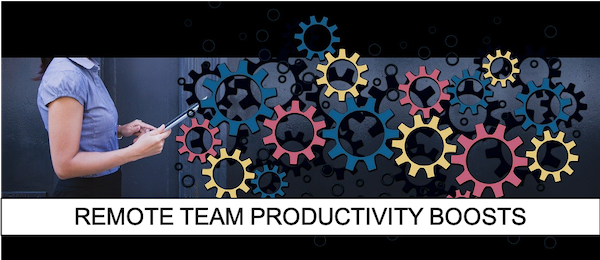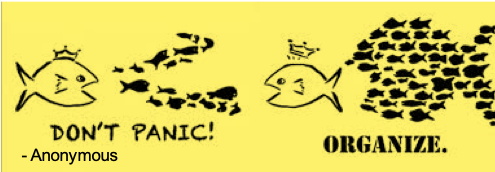
REMOTE TEAM PRODUCTIVITY BOOSTS
Tips and Tricks to address
STRESS, DISTRACTION and COLLABORATION
If you’re a Business Owner or Leader that is fortunate enough to have a business that offers a service that is needed right now and you are also able to offer that service over the phone or over the internet, then these 3 practices will help you to do that more successfully in these “COVID times”
We went from working in offices to working from home on mass in 3 weeks
In North America we went from working in offices to working from home on mass in less than 3 weeks. Some people arrived at work to be told that they were working from home starting the next day while others were given a bit more time as social distancing practises were put in place. Either way we collectively experienced massive change very abruptly and we humans do not always react well to this kind of change.
There has been more than 35 years of change management studies to draw on and they all agree that the success of a change initiative increases when there’s plenty of communication over a longer period of time and when people are given the opportunity to contribute to the change. Unfortunately, COVID-19 didn’t get the memo. So now we find ourselves dealing with the fall out of this massive change and the emotional chaos it’s brought up for everyone.
Collective Conscious
Spend a few minutes on social or watch the news and there’s no missing the amount of fear that we’re collectively feeling right now. We’re afraid of being infected, of running out of necessities, running out of money and a very uncertain future. When us humans are in that kind of fear, our survival instincts kick in and we have one of 3 reactions: Flight, Fight or Freeze or we cycle through all 3 of them over and over again.
Fear takes up 100% of our head space. Our reaction is primal, and our physiological response is immediate – our blood rushes away from non-vital organs and our adrenaline kicks in so we’re ready for that fight or flight the moment it happens.
The Effects on Productivity
This affects us Business Owners and Leaders because even though our team has physically shown up on their computers to work, their brain capacity is focused on the fears. This inability to concentrate is totally involuntary and not because they don’t want to. In fact, I’m pretty sure most of us would be grateful for a distraction from the fear but our brain’s physiology won’t allow us. Our brains are too busy being hyper vigilant, obsessing and assessing every little detail so we’re ready to run away or turn and fight for our lives unless we reduce that fear.
3 STEPS TO INCREASED PRODUCTIVITY
Step1: REDUCE your Team’s FEAR
Dealing with the emotional response to these “COVID times” is the first step towards productivity. Business has traditionally kept away from emotions. That perspective is slowly changing as we accept that mental health has a huge impact on business results but for the most part Business Owners and Leaders have a difficult time dealing with these delicate subjects. The idea of dealing with the volatile emotions that are coming up now leave many Leaders feeling unprepared, uncomfortable or even downright scared. Yet, as a Leader, that is exactly what we are called to do right now.
Reduce the fear by following these 3 steps:
1. Acknowledge the Fears: Acknowledge and allow your team to voice and air those fears. Remind them that their response is normal and physiologically programed into them. Then;
2. Reassurance and a Plan: Provide them with reassurance and a path forward. Talk to them about what you need to do to serve your customers now, your vision of what you want your business to be post-COVID and ask them for their input. When you do this, you provide your team with a more certain future and a purpose. Both reduce fear. Then;
3. Support: Give your team opportunities to support each other to achieve the vision you’re creating together. Start a regular group meeting where everyone shares their biggest challenge and their biggest need. Then encourage everyone to offer and give help by being a role model. Doing this regularly will create a cooperative environment where everyone feels like they’re in it together.
Step 2: Address DISTRACTION
Read any article written in the past 5 years on work from home productivity and you’ll find a section on reducing distractions like household chores, procrastination time sucks like social media or computer games, and interruptions from family.
COVID’s contribution
COVID’s contribution to these productivity sucks is physical distancing where everyone has been sent home. That means spouses, children, pets and sometimes extended family are all home at the same time and worse yet, they’re all bored. Which means there’s very little private space, it’s noisier and there are more people at home vying for more of your time and attention. Welcome to the new normal.
Give your team the tools and equipment they need to deal with these added distractions like:
- Dedicated access to High speed internet
- Whatever they need to set up a private workspace – from proper desks and chairs to partitions and noise cancelling headphones
- Implement core office hours
- Accept that distractions are the new normal and get your team’s input to a custom strategy to deal with it
- Use online team meeting software like zoom or GoToMeeting to do frequent check-ins
- Openly address family and home challenges
- Support your team immediately when you see the need – no judgements just help
Step 3: Increase COLLABORATION
Once you have practices in place to deal with the fear and the distractions, then you can address collaboration.
There are plenty of tools and apps out there to increase remote team collaboration but introducing yet another change in these stressful times may not be the best thing for your business right now. Instead, look at putting these 5 simple practices in place, and once they’re working well, then add in technology changes:
- Weekly Update Meetings: Have weekly update meetings with your whole team. Ask everyone to prepare for it by answering these questions: What are you working on right now? What is your highest priority? What is your biggest challenge? What support do you need to resolve your challenge and achieve your priority?Follow up their check-ins with your answers to the same questions.
- Common Challenges: Identify common challenges and themes, then ask your team to come up with suggestions on how to solve them.
- Brainstorming: Facilitate a weekly brainstorming meeting dedicated to solving these common challenges and themes.
- Track Progress: Keep track of the solutions that are implemented and recap them regularly so everyone can see how you’re making progress
- Celebrate: Celebrate those successes.
In my next blog I’ll be sharing Team Building Practices and Games to Inspire and Motivate that build on these 5 steps, so you can get even better engagement and collaboration.
In the meantime, I’m offering Free Open Office Hours in my Zoom Room over lunch on Tuesdays and Thursdays during these interesting times. Drop in and ask me any team related questions, and I’ll answer them.
Get your REMOTE TEAM and PEOPLE MANAGEMENT QUESTIONS ANSWERED
If you have questions about your remote teams, I hold FREE Virtual Office Hours in My Zoom Room on Tuesdays and Thursdays during these interesting times. Stop by with whatever team management questions you have, and I’ll provide answers.
Stop By My Zoom Room! The door will be open on:
Tuesdays and Thursdays from 11:00-12:30 Pacific Time.
Tuesday’s Link: https://zoom.us/j/590537679
Thursday’s Link: https://zoom.us/j/561968155
I look forward to meeting you and answering your questions, Angela

Founder and CEO
DreamTeam.Solutions
and
Crysalis People Solutions Inc.
Hi, I’m Angela Heit and I’m a self-professed serial entrepreneur. I’m currently running my third business and just launched my fourth. I was fortunate to have built my second venture into a multi-seven figure business in 4 short years before I sold it. So, I understand what it takes to grow a successful business and how the day-to-day demands keep you so focused in “do mode” that building leadership skills becomes a low priority.
‘Improving your leadership skills will increase your business growth and your day-to-day happiness’
For more than 25 years I’ve helped 100s of small business and fortune 500 clients build better teams. Based on that experience, I’ve launched DreamTeam.Solutions, a resource site for Business Owners and Leaders to learn from both the mistakes and successes of my clients.
From Leadership Skills Training that gets you results in just 15 minutes per day; to Practical Quick Tips; to Free Templates; to Coaching and Consulting Solutions, everything helps you make a bigger leadership impact that propels your business growth.
To your success,
Angela
Some past corp clients I’ve worked with









